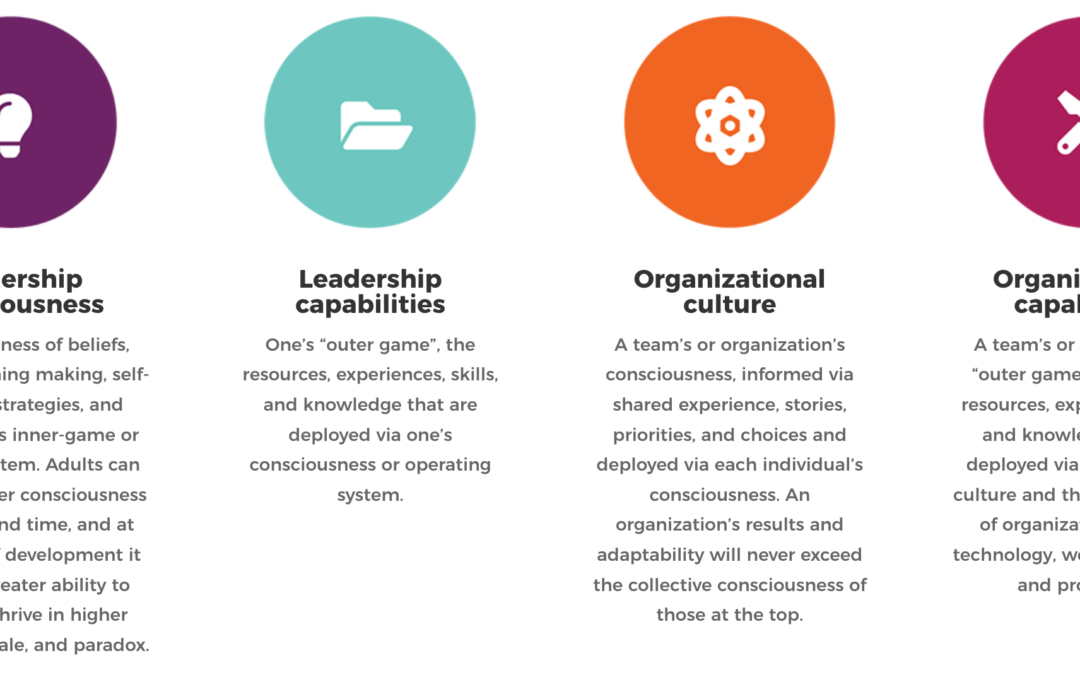If the pandemic has taught us anything, it’s that humans are quite capable of adapting even if we do so while kicking and screaming. It’s exhausting these days to just keep up on news, let alone juggling COVID protections, family life, new ways of working, changes in technology, consumer behaviour, etc. An adaptable person, team, and organization is often an agile culture, but that requires simultaneous work on all four quadrants of change and capability to achieve it. Here’s our model for what’s essential to creating and sustaining adaptable/agile people, teams, and organizations:
I liked this article from McKinsey because it gives some examples of how companies are trying new ways to become more agile and using all four quadrants to do so. It’s not enough to roll-out the new theme or strategies for the year; success and ongoing relevance / adaptability means developing the shared ability to learn quickly, execute, and experiment simultaneously. Here are a few nuggets I appreciate:
- Define the from–tos: “Each organization is unique. Accordingly, each needs its unique culture to power the new agile operating model. Organizations building an agile culture should base their approach on aspirational goals. They also need to understand their current culture, including the behavioral pain points that can be used as a starting point to articulate three to five specific mindset and behaviour shifts that would make the biggest difference in delivering business results.” This is true from an adult development perspective; to aim for something personally important is to self-author one’s life which comes with risk, and great potential rewards. It’s true from a structural thinking perspective because structure determines performance; no aiming, no moving towards something (a motivational purpose and emotive themes are key), and it’s true from a neuroscience perspective (people can only recall so much, so less is more if you want lasting change).
- Make it personal: This is about leadership consciousness; the organization’s performance cannot exceed the collective consciousness and capability of those in power. “In order to build an agile culture, Roche facilitated a deep, personal change process among senior leaders. More than 1,000 of these leaders were invited to learn a new, more agile approach to leadership through a four-day immersive program that introduced them to the mindsets and capabilities needed to lead an agile organization. The program, called Kinesis, focused on enabling leaders to shift from a limiting, reactive mindset to an enabling, creative one. It also started the journey of learning how to shift from a traditional organization designed for command, control, and value capture to an agile organization designed for innovation, collaboration, and value creation. A core tenet of Kinesis was invitation, not expectation.” As a result, they saw leaders independently experimenting with ways to be more agile in their teams and functions which is exactly the right way to go about change in high complexity environments.
- Culturally engineer the architecture: When I work with leaders I do my best to remind them that culture is both an enabler or inhibitor to change and organizational capabilities, AND a result of those things. “Even the best-designed culture programs can fail if the surrounding context does not support—or worse, hinders—new mindsets and behaviours. To sustain a new culture, the structures, processes, and technology must be redesigned to support behavioural expectations. To be successful, the desired culture change needs to be hardwired into all elements of the business-as-usual organization as well as the transformation.” To put it differently, if your brand and values reflect HOW you hope to operate as an organization, then any programs, change efforts, and metrics need to get specific about what “good” looks like (or if easier, provide the anti-example). What are the proof-points of this value or brand attribute in the life cycle of a customer? What practices, rewards, stories, role models, structure, processes, interdisciplinary collaborations (or lack therefore) reflect your desired culture and capabilities? There will always be a gap; the trick is to remember that culture and capability are a result of the interplay between all four quadrants above.
- Monitor and Learn: “Continuous learning and improvement is a core principle of agile working. It applies to agile culture as well. Successful agile transformations have shown the value of monitoring progress, evaluating behavioural change and its impact on performance, and running regular retrospectives to learn from successes and failures. However, measuring behavioural change has traditionally been a challenge.” Developing culture and capability is a fantastic way to grow your leaders, and to help everyone tightly align on the link between values, brand promise, capabilities (individual, team/function, and company). Culture is not fixed because life is always changing, and the application of values and brand promise is contextual to your environment, current capabilities, and aspirations. Because capacity is nested it’s crucial to develop your people to enable and empower them to own the culture and capabilities, and it’s an ongoing exercise.
How’s your organizational culture and capability dynamic compared to your aspirations?
I hope this has been helpful and of course the Adaptive Talent team would welcome the opportunity to help you and your team improve your results and adaptability via our culture and organizational development consulting, communications and coaching / mentoring training, total rewards consulting, assessments, leadership coaching and development programs and retained search to help you land high impact talent.

